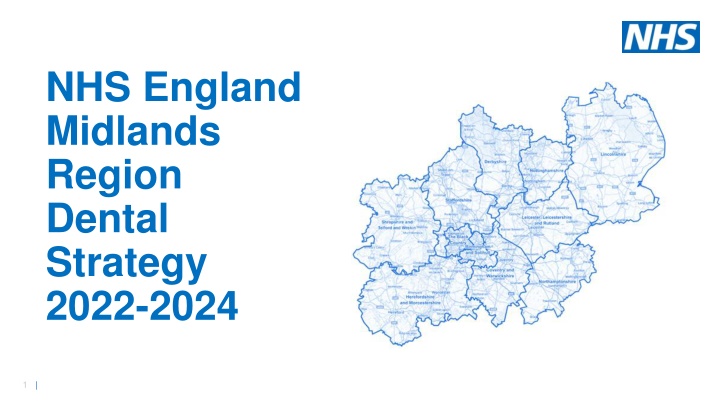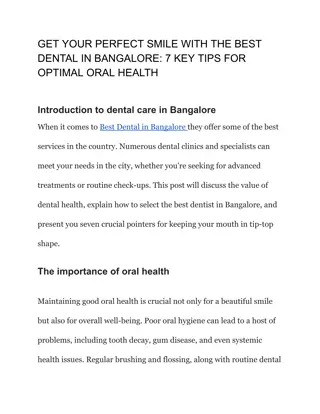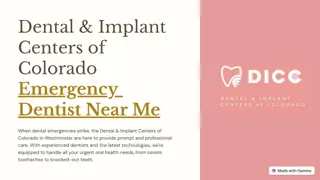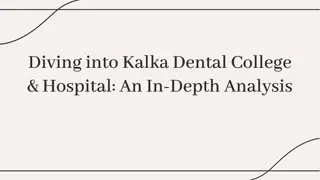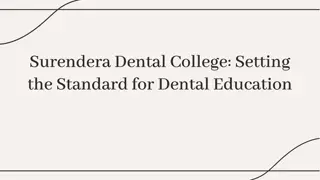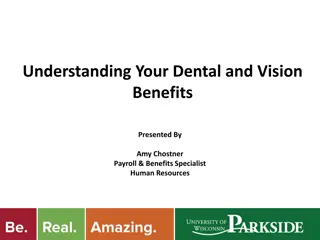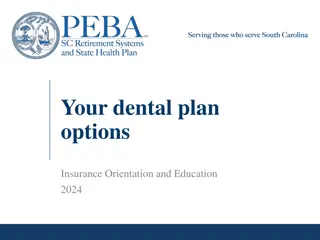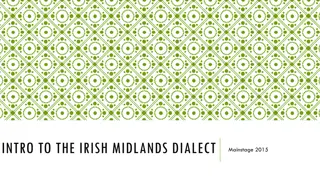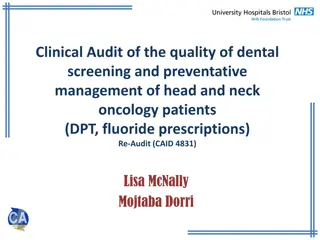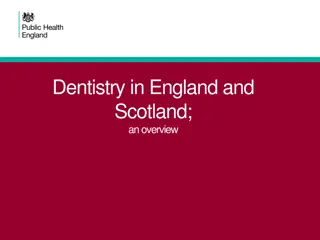Midlands Region Dental Strategy 2022-2024 Overview and Focus Areas
Prepared to assist Integrated Care Systems in tackling dental commissioning challenges in the Midlands, this strategy emphasizes strategic coherency, efficiency, and sustainability in dental services. Key objectives include addressing COVID-19 effects, regional oral health disparities, inequities in access, and promoting collaboration to enhance care provision.
Download Presentation

Please find below an Image/Link to download the presentation.
The content on the website is provided AS IS for your information and personal use only. It may not be sold, licensed, or shared on other websites without obtaining consent from the author.If you encounter any issues during the download, it is possible that the publisher has removed the file from their server.
You are allowed to download the files provided on this website for personal or commercial use, subject to the condition that they are used lawfully. All files are the property of their respective owners.
The content on the website is provided AS IS for your information and personal use only. It may not be sold, licensed, or shared on other websites without obtaining consent from the author.
E N D
Presentation Transcript
NHS England Midlands Region Dental Strategy 2022-2024 1 |
Context This document has been prepared to aid Integrated Care Systems (ICSs) in understanding the common issues relating to dental commissioning across the Midlands that NHSE has been responding to in recent years and the plans previously in place relating to these. This strategy is supported by the ICS Data Dashboards that have been produced and circulated to systems. These ICS level dashboards will be updated quarterly and are designed to give information to ICS to allow them to consider the necessary plans and approaches for dental services that will need to be included in their local system strategies. Each system will be unique in terms of the current situation and historical background. It is likely that the prioritisation in each system will depend on a wider local system strategy informed by population health management. Systems will need to consider what is achievable and what they may be willing to resource as part of those wider plans. As priorities in individual areas may naturally differ, careful consideration will need to be given as to whether or not some initiatives are better tackled on a wider scale this may give economies of scale and prevent duplication of work across systems. There are likely to be some local initiatives necessary to tackle particular issues in individual areas but there are potentially other wider pieces of work that can be undertaken jointly but with consideration given to the timetable for a roll out across different areas. 2 |
Across the Midlands geography, dental services are facing pressures, both in terms of the demand being placed on them, their sustainability and the resources available to provide those services. The purpose of this document is to bring strategic coherency, efficiency and consistency to the commissioning of dental services across the Midlands with the intention of: Enabling the public to access dental care that is safe, high quality and at a convenient time and place, making services sustainable and able to flex to meet anticipated fluctuations in demand. Ensuring value for money is always achieved, demonstrating that NHS England (NHSE) is effective in its stewardship role of public funds. Ensuring services are commissioned in line with the needs of population to improve and maintain oral health. EXECUTIVE SUMMARY It is expected that local commissioners will work closely with Managed Clinical Networks (MCNs), Local Dental Networks (LDNs), Health Education England (HEE) and Consultants in Dental Public Health (CDPH). Together they will be responsible for ensuring the optimal patient pathway possible, supported by specialist advice and/or access to care, that meets the needs of the local population whilst achieving the nationally expected standards of care provision. The Midlands Dental Strategy 2022-24 will aim to: Address and remedy the reduction in throughput of patients due to COVID-19 and flex as COVID-19 continues to challenge delivery and access to care; Address regional inequalities in oral health, which have been exacerbated by the COVID-19 pandemic which has had a greater impact on those in more deprived and vulnerable groups of society; Address inequity of access across the life course including the impact of rurality; Align to the NHS LTP, encouraging LDNs to support local dental providers to work collaboratively within their ICS to meet the needs of local communities, particularly for the vulnerable or less likely to engage. Dental services have a significant transformation opportunity as there is long standing inequality of access, which is demonstrated in the per head of population variation in both spend and access. Any plans need to take account of the needs of people classed as vulnerable/hard to reach/irregular attenders (those experiencing Severe and Multiple Disadvantage SMD). The pandemic has increased longstanding problems with access and there has been growth in long waits for many specialties, including for orthodontics or paediatric dentistry. 3 |
Primary Care Services Dental Services NHS Primary Care Dental Services are the main point of contact and undertake the care of oral health needs for members of the population that choose NHS dental care. Independent Providers are commissioned via General Dental Services contracts or Personal Dental Services agreements in accordance with national regulations to provide a full range of level 1 care under NHS terms. Patients are not registered with a practice but regular attendance may be informally regarded as such for those attending within a two-year re- attendance period. There are no limitations based on patient residence. Care provided includes routine assessments and urgent appointments including, where necessary, radiographs to assist in treatment planning. Preventative care includes advice and, where appropriate, the application of Fluoride Varnish or Fissure Sealants. Treatment may include fillings, extractions and root canal treatment (endodontics) as well as wider oral health matters such as gum disease (periodontics) or referral for specialist consultation where an oral cancer is suspected. Some interventions may include laboratory prepared restorations for instance crowns, bridges, partial or complete dentures. Treatment is assigned to one of three treatment bands or urgent care that is used as the basis for renumeration of the contract holder. Some categories of patients will not be required to pay for treatment (including all children) but others pay a charge in line with the band of treatment. Under certain circumstances, further treatment within a short timescale may be provided free of further charge. Orthodontics (relating to improvement of appearance, position or function of crooked or abnormally arranged teeth) is provided in specified circumstances and there is a standard method for assessing whether treatment is clinically necessary and available under the NHS. A small number of contracts operate under Prototype (Dental Contract Reform) arrangements as part of a national initiative exploring different methods of contract incentivisation. The contract holders may be independent individuals, partnerships or corporate providers. The dentists working under the contract are required to be included on the NHS National Performers List and other members of the team such as dental nurses are also required to be registered with the relevant professional bodies. Contract delivery and the outcomes of the services provided are monitored in comparison to nationally set standards (e.g. contract delivery versus target) or national and regional norms (e.g. rates of Fluoride Varnish preventative interventions). 4 |
Community Dental Services Community Dental Services is a referral service which provides services to children and adults. It is concerned with the provision of dental care and enabling the improvement of oral health for individuals and groups in society who have a physical, sensory, intellectual, mental, medical, emotional or social impairment or disability, or more often, a combination of a number of these factors. As such, care will be provided to patients who have a need beyond the skill set and facilities of a general dental practitioner (high street dentist). Community Dental Services provide dental treatment under general anaesthetic (GA) in secondary care sites with access to critical care facilities for children who require multiple tooth extractions, children with complex health needs and who require restorative treatment, for children when it is not possible to provide dental care using alternative treatments methods and for adults with special needs that may impact upon their ability to co-operate. The Community Dental Services also provide additional services, for example oral health promotion, epidemiology for Local Authorities, outreach projects for vulnerable groups. The GA pathway is commissioned under the PDS contract under a shared care arrangement, although there are problems with this arrangement and a lack of clarity regarding governance. There is a particular issue in Worcestershire with a lack of clarity regarding joint working between the community and acute trusts - particularly around special care GA. Epidemiology and Oral Health Promotion in Herefordshire is procured separately by the LA as funding for this aspect transferred in 2013. 5 |
Intermediate Minor Oral Surgery (IMOS) Level 2 The specialty of Oral Surgery deals with the diagnosis and management of pathology of the mouth and jaws that requires surgical intervention. Oral Surgery involves the treatment of children, adolescents and adults and the management of dentally anxious and medically complex patients. Oral Surgery care is provided by Oral Surgeons and by Oral & Maxillofacial Surgeons as the clinical competencies of these two specialties overlap. The IMOS service provides minor oral surgery treatment (e.g. teeth extraction of special difficulty, wisdom teeth removal, apicectomies) for adults where the surgery is too complex for the referring general dental practitioner and does not meet the secondary care dental complexity criteria. Intermediate Minor Oral Surgery Level 2 can be performed within a primary care or a secondary care setting. Level 2 care is defined by complexity of treatment requiring a clinician with enhanced skills and experience who may be on the General Dental Council Specialist List or Accredited by NHSE. Commissioned IMOS Level 2 services have a defined referral pathway. Existing contracting arrangements varies across the Midlands region e.g. access for patients who meet the clinical criteria aged 16/17 or 18 years or above and is commissioned within primary, secondary and community care. The provision of adequate anxiety control is an integral part of modern dental practice. Often this can be achieved with effective local anaesthesia and quality behavioural management techniques, yet there will be patients who require additional pharmacological support to enable them to undergo/accept dental treatment. This may particularly be the case if the treatment required is invasive or lengthy, as in the case of many minor oral surgical procedures. As such there is a necessity for appropriate, safe, predictable and effective intravenous Conscious Sedation techniques to facilitate minor oral surgery procedures. However, access to sedation varies across the different STP/ICS areas. IMOS Level 2 services can be commissioned under a time limited Personal Dental Services Agreement with either a cost per case or with an annual activity target and contract value if delivered in a primary care setting. If delivered within secondary care dental, then this would be incorporated into the annual NHS Standard Contract with the Acute Trust. IMOS providers activity is monitored via the Referral Management System and submissions of FP17s to the Business Service Authority. NHS England Dental Commissioning Guides provide details of competency levels and standards required. Further details are available at: https://www.england.nhs.uk/primary-care/dentistry/dental-commissioning/dental-specialities/ 6 |
Secondary Care Dental Services As part of its direct commissioning responsibilities, NHS England commissions all NHS dental services: primary, community and secondary care services, including dental hospitals and urgent dental care services. The majority of Secondary Care Dental services are specialist services at Level 3 but may incorporate Level 2 services where these are not separately available. All Secondary Care Dental services are commissioned under the NHS Standard Contract with annual renewal possible through the contracting round. At a national level the majority of specialist dental services are delivered in secondary care settings, in acute hospitals, foundation trusts, district general hospitals and dental hospitals funded by national and local tariff arrangements. Specialist dental services are listed below*, however, some of these are recognised as multi-disciplinary care (dental and medical specialties). The definitions listed are in line with the General Dental Council: Special care dentistry; Oral surgery; Orthodontics; Paediatric dentistry; Restorative (endodontics, periodontics, prosthodontics, implant dentistry); Oral medicine; Oral microbiology; Oral and maxillofacial pathology; Dental and maxillofacial radiology; Oral and maxillofacial surgery. * Not all services are provided at every secondary or tertiary provider. In the Midlands region there are 24 providers of Secondary Care Dental Services, 16 in the West of the region and 8 in the East, including two regional services at Birmingham Dental Hospital and Birmingham Women's and Children's Hospital and one Independent Sector Provider. The Birmingham Dental Hospital is also home to the University of Birmingham School of Dentistry. Additionally, Secondary Care Dental Activity for the Midlands is commissioned from four 'Out of Region' providers and there is a further Independent Sector Provider currently commissioned by the local CCG which needs to be regularised. All providers of Secondary Care Dental Services are subject to local and national performance indicators, such as RTT, and regular reporting of activity and finance data. Service Specifications have been drawn up for Orthodontics, Oral Surgery and Oral Medicine to be included in contracts when contracting resumes following the pandemic. 7 | Further Service Specifications for Maxillofacial Surgery and other specialties are to be written by Commissioners.
Background Over recent years NHS services faced significant challenges to the sustainability of service provision across the complete range of dental activity including general, specialised, urgent, secondary and tertiary specialist dental treatment and prevention programmes. These challenges are increasing year on year including but not limited to: Primary Care Falling levels of dental access, especially for those in more vulnerable groups, in part due to population growth and difficulties with staffing. Significant numbers of providers under delivering on contracted activity levels. Difficulties in recruiting and retaining all members of the dental team. Lack of flexibility on UDA rates. Ongoing shortfall in orthodontic capacity due to a delay to the planned region wide orthodontic procurement. Significant numbers of contract change requests and legal challenges. Capacity in practices remains restricted due to ongoing enhanced IPC measures and the need for down time between procedures which limits the throughput of patients. Pressure on Dental Access Centres (DACs) due to private patients repatriating into NHS, patients without a regular dentist and the challenge of getting appointments in high street dental practices. Community Lack of theatre access for paediatrics and special care GA and some restored sessions are now being cancelled due to Trust workforce or premises issues. A regional review of prioritisation of surgical and paediatric cases using HAPPS Tool may impact on current theatre access due to lack of dental information in the tool. Lack of general capacity for managing existing case load and new patient assessments for both paediatrics and special care. Increase in inappropriate paediatric referrals following the pandemic. Restoration may be constrained by premises issues that restrict the type of clinics provided in some settings particularly for AGP. Significant waiting list backlogs. Increased use of remote triage and of sedation, stricter application of criteria for domiciliary visits following risk assessment. IMOS Lack of parity and equitable access for Intermediate Minor Oral Surgery (IMOS). There is a complete lack of IMOS access in some areas, for example, Birmingham, Solihull, Worcestershire and the Black Country and consequent pressure on hospital services. Limited or lack of access to IMOS treatment under Conscious Sedation across parts of the region. Financial risk of over performance on some historic uncapped activity-based contracts. Some providers remain constrained with reduced capacity due to social distancing requirements in waiting rooms and the need for down time between procedures. Significant waiting list backlogs in some areas. Secondary Care Pressure on access to oral surgery and wider dental services as Maxillofacial Departments deal with an increase in urgent cancer cases (head and neck cancer or skin cancer). Significant waiting list backlogs leading to a deterioration in referral to treatment times and an increase in patients waiting for routine treatment including a large and static number of 52 week waits and a smaller number of 104 week waits with a few providers. Workforce issues: Trusts struggling to recruit Orthodontic Consultants which is impacting on capacity. Previous impact and ongoing risk of loss of capacity at some Trusts due to COVID pressures and redeployment of staff. 8 |
Scope of the Strategy Primary, community, secondary and tertiary services SpecialCare Dentistry Orthodontics Oral Surgery Urgent/Unscheduled Care Prevention and Oral Health Paediatric Dentistry 9 |
Currently commissioned dental activity in ordinary 'High Street' practices The picture in terms of activity commissioned is variable and ICS level figures can be misleading with some areas more significantly impacted than others even within a system. For example, the individual figure for Herefordshire is 1.15. There are also some issues with the level of commissioned activity that is being delivered as it is very difficult to rebase contracts unilaterally and in recent years there has been under delivery, particularly in rural areas due to problems recruiting and retaining dentists. Access has been lost historically in some areas, although there is now a policy to recommission activity lost within each system, but this will be in the areas most in 10 | need.
Units of orthodontic activity commissioned in ordinary High Street practices Primary Care orthodontic activity is commissioned via PDS (ortho) or GDS (mixed) contracts. The PDS contracts (agreements) provide only orthodontics and account for the majority of the primary care ortho provision. These agreements are time-limited and subject to procurement regulations. The GDS contracts provide both mandatory services (general dentistry) and orthodontic services. These contracts are not time-limited and are, therefore, held in perpetuity by the provider unless either party terminates in accordance with the terms of the contract. 11 |
Community Dental Services Total Contract Value for Community Dental Services West Midlands 31,312,761.67 Total Contract Value for Community Dental Services East Midlands 17,402,649.31 There are 9 providers in the West Midlands There are 2 providers in the East Midlands Services across the Midlands are not easily comparable as over the years many have been commissioned to provide a range of other non core services such as Dental Access Centres, Minor Oral Surgery, Orthodontics or Out of Hours, etc. A programme of work is underway across the Midlands to standardise services in line with the national commissioning guide using a locally developed specification. This is being progressed by redesign and there has been a benchmarking exercise in the West Midlands to review funding as a baseline for considering any necessary investment to support these changes. 12 |
Intermediate Minor Oral Surgery (IMOS) Level 2 IMOS provider activity is monitored via the Referral Management System and submissions of FP17s to the Business Service Authority. NHS England Dental Commissioning Guides provide details of competency levels and standards required. Further details are available at: https://www.england.nhs.uk/primary-care/dentistry/dental-commissioning/dental-specialities/ Primary Care Level 2 IMOS provider activity is monitored via the Referral Management System and submissions of FP17s to the Business Service Authority. There is currently inconsistent primary care Level 2 IMOS provision across the Midlands. Some areas have Level 2 IMOS services in primary care which have either been recently recommissioned in Staffordshire (Stafford and Stoke- on-Trent) and Shropshire (Telford) or are about to be recommissioned across the East Midlands and a re-run of the Shropshire and Staffordshire procurement (for Shrewsbury and Burton-on-Trent). There are also retained legacy arrangements (in Coventry and Warwickshire) and other areas such as Birmingham and Solihull, the Black Country and Worcestershire that have no current primary care provision, although contracting arrangements are in place for Level 2 activity to be delivered as part of the secondary care contract, a community provider (Herefordshire) or a independent sector contract (Birmingham and Solihull). 13 |
Secondary Care Dental spend by ICS Oral & Maxillofacial Surgery 8,124,608 5,046,748 5,681,831 5,890,575 3,900,981 4,816,088 6,906,120 Other dental specialties Orthodontics Grand Total BIRMINGHAM AND SOLIHULL ICS COVENTRY AND WARWICKSHIRE ICS HEREFORDSHIRE AND WORCESTERSHIRE ICS JOINED UP CARE DERBYSHIRE ICS LEICESTER, LEICESTERSHIRE AND RUTLAND ICS LINCOLNSHIRE ICS NORTHAMPTONSHIRE ICS NOTTINGHAM AND NOTTINGHAMSHIRE HEALTH AND CARE ICS SHROPSHIRE AND TELFORD AND WREKIN ICS STAFFORDSHIRE AND STOKE ON TRENT ICS THE BLACK COUNTRY AND WEST BIRMINGHAM ICS Grand Total 1,079,077 2,548,614 924,236 999,146 2,071,643 1,068,890 507,778 1,006,125 1,365,390 729,883 11,752,299 6,625,029 7,217,502 9,031,108 5,414,885 6,363,265 7,745,508 654,045 536,526 181,787 109,505 4,106,785 755,427 461,725 5,323,937 2,625,314 8,404,775 9,543,383 65,047,207 13,357,805 9,705,077 732,122 2,407,864 1,785,238 1,879,437 13,208,058 311,790 946,633 3,669,226 11,759,272 88,110,089 Note spend is calculated based on patient location (as distinct from the location where service provision occurred). These figures do not, therefore, represent the contract values for Providers in each ICS area but instead the expenditure on patients resident in that area. 14 |
Impact of COVID 19 Primary Care The dental sector has faced particular challenges during the pandemic due to the relatively high proportion of aerosol generating procedures (AGPs) undertaken and the stringent IPC protocols in place to ensure safety of both patients and staff. Capacity in practices was severely restricted due to social distancing requirements in waiting rooms and the need for down time between procedures which limits the throughput of patients. Activity was almost completely suspended between 25 March and 08 June 2020 with urgent activity being undertaken through Urgent Dental Centres (UDCs) and Out of Hours services, and remained at levels between 20-30% until December 2020. On a regional basis the pandemic has had a detrimental impact on patients access to primary care general dental services, some examples being Lost courses of treatment (April 2020 February 2022) = 7,890,411 (equal to all practices fully closed for 12 months). Effect on 24 month count of unique patients seen (April 2020 March 2022) down 1,659,079 patients. There has been a significant recovery commencing from January 2021 but levels remain at about 78% of commissioned level for general dentistry and 92% for orthodontics (both 2021/22 Q4 scheduled). Due to the restricted capacity, there is still limited availability of routine care and the focus has only recently changed from urgent care and vulnerable patients rather than providing routine check-ups. This has resulted in a significant decrease in access for both adults and particularly children, although access for children is recovering at a faster rate than for adults. The impact on access has been variable, irregular attenders have been significantly affected, which increases health inequalities. Children were particularly impacted early on in the pandemic but access for this group appears to have recovered more quickly although this may be down to this being monitored on a one year rather than a two year attendance. 15 |
Impact of COVID 19 Community Dental/IMOS The Midlands Community Dental Services (CDS) providers played a vital part of the Urgent Care System either as Urgent Dental Care Sites (particularly sites for COVID symptomatic patients or for vulnerable or shielded patients) or by providing referral hubs to feed other UDC sites in the West Midlands. Many CDS in the West Midlands continue to operate as Dental Access Centres which are crucial to coping with the large number of vulnerable patients without a regular dentist who are struggling now to access services through general dental practices. As with Primary Care Dental services, there are several complexities affecting recovery which continue: Clinic activity is still reduced due to AGP fallow time requirements, available clinical space, requirements for social distancing and shared waiting rooms; Premises restraints due to single surgery sites, infection control processes and lack of additional space, therefore, continue to restore as non AGP. Increase in number of short notice cancellations that continues to affect the number of patients being treated. In terms of clinical sessions and restoration to previous levels, this is not yet restored to 100% due to the constraints above and continues to range from 70% up to 90%. All providers have a significant existing caseload due to the patient groups served and are still working to restore routine follow ups for these patients. Access to CDS GA sessions for Paediatric and Special CareAdults dentalcaseshad been restricted until theatre lists fully restored. This has led tolong waits for treatment for routine care and remains challenging in some areas. CDS contracts are paid on block arrangements and some contracts remain on payment protection e.g. management of key performance indicator payments. The IMOS delivery position continues to remain at 90%+ of the previous 2019/20 level of referrals. There are some IMOS providers which continue to exceed their previous activity levels as they tackle their backlogs. During 2020-21 IMOS providers moved from protected income arrangements to cost per case activity and payments and this was completed by December 2021. IMOS waiting position remains challenging in some areas with patients waiting over 18 weeks to access treatment. 16 |
Impact of COVID 19 - Secondary Care Secondary care dental services have been severely impacted by COVID this is due to IPC measures, staffing issues (redeployment or sickness) or constraints on physical space particularly theatres. Current capacity is roughly three-quarters of pre-COVID levels. Each Trust is in a different place in terms of capacity and backlog. In the worst cases, big Trusts who dealt with the most COVID cases will have been closed to all other work and lost a significant part of a year s activity particularly for routine cases. Some will have also had pre-existing pressures. Others have been able to continue some level of routine care. The level of routine referrals was greatly reduced during most of the year due to restrictions in primary care. The scale of missed appointments or operations is so large that a phased approach is needed. The roadmap to recovery focusses on initial crisis management, recovery and normalisation. Each Trust is at a different point in this journey. Patients are being seen and treated based on clinical prioritisation and for some Trusts maintaining urgent capacity is a challenge at this stage. This is because there is competition for space (including theatres) with other departments. Capacity for dental recovery may be further constrained due to max fax/oral surgery teams focussing on other priority trust work - examples are head and neck or skin cancer work. These may be encompassed in wider ICS plans although some funding requests have been received. 17 |
Road Map to Recovery Phase 1 Phase 2 Phase 3 Initial Responses Recovery Phase Normalisation Risks Due to delays with the vaccine and lockdowns, this road map would be a live document and would need updating on a regular basis. Secondary Care: Continued prioritisation of patients according to clinical need and reduction of backlog through waiting list initiatives including additional intermediate capacity (see below). Secondary Care: Block contracts continue nationally and activity targets planned. Majority of dental patients are low priority within trusts which causes issues with access to services. The use of AGP, open bays and shared waiting rooms means capacity is reduced in line with IPC and social distancing protocols. Focus on ensuring on-going access for urgent cases and beginning to clear backlogs based on clinical prioritisation rather than on length of time waiting. Strict adherence to acceptance criteria (impact on primary care). Commissioning of additional intermediate services to take cases from hospital waiting lists Secondary Care: Return to normal provision of services with focus on waiting times. Continued development for improvement in services where possible. Community Dental Services: Return to normal provision of services with focus on waiting times. Continued development for improvement in services. The following would have an impact: Community Dental Services: Ongoing management of existing and new caseload and development of additional Oral Health Promotion schemes. Development of services for patients in care homes. Focus on paediatrics ensuring appropriate care is delivered by GDPs and increasing secure access to GA facilities. Focus on backlog where not already addressed. Further restrictions due to COVID impact in hospital services Primary Care: Steady state for Dental Services, back logs reduced where patients can access dental services with improved access to allow NICE recommended recall schedules. Review of OH Services, Innovative Commissioning including Prevention and Flexible Commissioning. Dental funds/allocations Changes to the targets Primary Care: Prioritisation of urgent cases and vulnerable patients. Working towards normal recall schedules for patients without significant oral health needs. Increased commissioning of intermediate services where capacity allows. Community Dental Services: Capacity currently constrained with particular impact on GA due to lack of access to theatres. Increased waiting times for paediatric and special care patients with longer intervals for review. Focus on stabilisation of patients. Increased need due to deterioration of oral health during the pandemic. Primary Care: Practices working at 60% capacity with additional schemes for weekend working and to improve access for urgent cases via 111. Prioritisation of urgent and vulnerable patients. Innovative ways of directing patients to the right place to get routine/urgent and necessary dental services. Focus on developing access to services for those with SMD. Timescale: 6 - 12 months (to achieve by April 2022) Timescale: 12 - 48 months (to achieve by April 2025) Timescales 48 - 60 months (to achieve by April 2026 ) 18 |
2021/22 Restoration Initiatives Weekend Access To increase face-to-face dental access over and above any national activity targets. The Midlands Region commissioned additional non- recurrent weekend activity to be delivered on a sessional basis for the 33 week period between 14 August 2021 and 31 March 2022. During this period, 21,200 patients were seen at the additional weekend sessions and 20,910 were signposted to reserved urgent access appointments at participating practices (Monday to Friday); 42,110 additional patients were seen in total. Access to Urgent Care There has been a focus on gaps in provision for weekday OOH/in hours where no Dental Access Centres or 8-8 cover is in place. The intention is to improve access for those without a regular dentist who are struggling to access care. This is really important and links to one of the risks from a patient safety perspective but also in terms of the fact that it is exacerbating health inequalities. Potential to expand the service to use flexible commissioning to address irregular attenders high dental needs. Scoping a pathway to provide practices incentive to stabilise these patients ready to be acceptable back into normal preventative care. Ventilation and Filtration NHSE offered capped financial support for practices to undertake a basic ventilation and filtration survey to understandtheir current premises position and how ventilation and filtration can be improved within practice to maximise throughput. Paediatric Shared Care Pathway A paediatric shared care pathway has been developed whereby CDS services triage their referrals and send appropriate cases to identified practices who have been selected as Community Service Support practices; at the same time, rejecting any inappropriate referrals back to GDPs where they should be managed. IMOS Waiting list initiatives During 2021/22, 1.1m was invested in additional IMOS activity to reduce the number of patients waiting and waiting times. National access investment The Region commissioned 2.2m of additional activity to increase access in primary, community and secondary care. An additional 3,289,37 and 79 sessions respectively delivering an additional c 13,000 appointments. 19 |
Investment Plans 2022/23 RTT investment - 2022/23 Secondary care waiting lists - funding to develop innovative schemes to increase capacity including Community Dental initiatives. 2022/23 Weekend Access Scheme - in line with the 2021/22 Scheme will commission from 06 August 2022 until 31 March 2023. IMOS Restoration (East) and waiting list reduction where IMOS providers exist - funding to develop innovative schemes to increase capacity due to reduced patient throughput (East Region) (providers in primary and secondary care). IMOS Restoration and waiting list reduction where IMOS providers exist - via over-delivery in Shropshire and Staffordshire. Children s access - CDS Support Practice scheme to include Looked after Child Pilot Dudley. Advice and guidance Pilot on DeRS for Orthodontics in the West. "Golden Hello" to recruit dentists into hard to recruit areas. Additional Warwickshire Routine Access either via EOI or procurement (Rugby) as benchmark very low and previous termination - this is additional. Urgent Care Vulnerable Groups including homeless and refugees (EOI) pilot and Scheme for evacuees/refugees and access for areas of high deprivation via an outreach service via flexible or additional or both. Urgent Care Vulnerable Groups including homeless and refugees, recurring post pilot (placeholder for procurement). Procurement of IMOS in the West Midlands. Extend temporary children's weekendaccess sessions in Herefordshire (pending procurement). 20 |
Secondary Care and Community Dental Investment Programme An Investment Programme spanning 2021/22 and 2022/23 is in progress. In 2021/22, 26 schemes with a total value of 3.7 million were approved. We are awaiting the final activity figures for these schemes. Provisionally,14 schemes are continuing into 2022/23 with an associated funding value of 2.0 million. This is being finalised as part of the current 2022/23 contracting round. The schemes approved include: Waiting list initiatives (in-house and outsourced) Redesigned one stop pathways Adoption of new skill mix models Use of telephone and video triage Waiting list validation Utilisation of independent sector capacity This funding is providing treatment to additional patients across a range of dental specialities, including paediatric GA cases which have been a particularly challenged area. 21 |
GIRFT (Get It Right First Time) Oral Surgery and Hospital Dentistry Clinical Review We are seeing an increase in surgical waiting lists for elective surgery as a result of the COVID 19 pandemic. In support of the challenges being faced, the regional team will work alongside the Getting It Right First Time (GIRFT) team to deliver a programme aimed at the restoration and recovery of elective services in Hospital Dentistry (with a particular focus on Oral Surgery). The programme will see a series of GIRFT reviews based on clinical data and clinical discussion to drive improvement initiatives with the aim to reduce patient waiting times and remove unwarranted clinical variation. The regional GIRFT team will deliver the gateway reviews in alignment with the already established Local Dental Networks, which ensures that systems are paired together ensuring a benchmarked comparison of services across a number of providers. This should encourage clinical integration and also local review. The GIRFT team will follow up and support with the delivery of clinical recommendations at provider level and agreed actions at system level. Any regional themes identified and improvements delivered will be shared as examples of good practice along with case studies. A launch webinar was held with stakeholders and GIRFT on 25 April 2022 and Gateway Reviews will take place during June 2022. 22 |
Improving Oral Health in the Midlands In terms of this strategy, it is important to note the significant role which oral health improvement plays in the future demand for NHS dental services. Local Authorities are responsible for: Oral health promotion programmes. Oral health surveys to facilitate the assessment and monitoring of oral health needs, planning and evaluation of oral health improvement programmes, planning and evaluation of arrangements for provision of dental services as part of the health services, and where there are water fluoridation programmes affecting the authority s area, the monitoring and reporting of the effect of water fluoridation programmes (The NHS Bodies and Local Authorities (Partnership Arrangements, Care Trusts, Public Health and Local Healthwatch) Regulations 2012). The NHS Bodies and Local Authorities (Partnership Arrangements, Care Trusts, Public Health and Local Healthwatch) Regulations 2012 (legislation.gov.uk). Local Authorities may produce oral health needs assessments and oral health strategies as a result of these responsibilities. It is, therefore, critical that this dental strategy is read in conjunction with all available oral health strategies and oral health needs assessments covering the Midlands area. NHSE and ICSs must work in collaboration with Local Authorities and other local partners to deliver the optimal impact on oral health and demand for dental services, reducing inequalities in oral health. The NHSE commissioning team are working with Community Dental Services to support development of a more resilient oral health improvement service for each ICS that will work to a standard specification and reporting. The work is being done collaboratively with partners including Local Authorities. 23 |
A 5 year old childs experience of oral health and dental services 38.6% of all 5 year olds in Leicester in 2019 had already experienced decay compared to 14.2 % in Staffordshire. In 2019/2020 the percentage of children who had visited an NHS dentist within the previous 12 months in the Midlands was 52.9%. In the old NHSE West Midlands area the 12 month access rates at March 2020 for 5 year old children vary from 44.5% in Sandwell to 63.0% in Warwickshire. The rate of Fluoride Varnish treatments for children aged 3-16 years per 100 FP17s ranges from 61.3% in Shropshire and Telford and Wrekin ICS to 74.2% in The Black Country and West Birmingham ICS in 2019/2020. The child s parents should have received advice about oral health from pregnancy so that their child has the best chance to grow up with good oral health. Midwives, Health Visitors and other health and social care professionals should provide consistent oral health advice to parents/guardians to support their child s oral health. This includes advice about the need to take their child to the dentist from a very young age. In their school or nursery they could have already been part of a Supervised Toothbrushing Scheme to support early adoption of good toothbrushing habits using the correct amount of fluoride toothpaste for their age (a pea sized amount of adult-strength toothpaste containing at least 1,000 ppm fluoride). They may live in an area which received fluoridated water at 1 part per million, the optimum level to prevent dental decay. A 5 year old child should have already been taken to a local dental practice when they were very young for their first check up, preferably before the age of one year. Children aged 5 should have a dental check up at least once every 12 months. The dentist will give advice to the parent or guardian about oral health and, if possible, check their teeth, gums and mouth for signs of oral disease. Other dental care professionals in the practice will also give advice and all advice should be based on Delivering Better Oral Health. All children between the ages of 3 and 16 years of age should have Fluoride Varnish applied to their teeth at least twice a year and this increases to 4 times a year for those children most at risk of poor oral health. When a child aged 5 needs dental treatment they may be able to have treatment under local anaesthesia alone (an injection into their gum to numb the tooth and surrounding area) but if more than one tooth needs treatment then often they will have those teeth extracted under general anaesthesia in a hospital environment. This will be carried out by people with skill and expertise in Paediatric Dentistry, usually employed by a Community Dental Service and linked to the Paediatric Dentistry Managed Clinical Network. Their dentist may be trained in spotting signs of domestic abuse, having accessed training, and so be ready to support and signpost their parent if necessary, delivering their important safeguarding role alongside other healthcare professionals. More data about oral health and dental services is available in the ICS reports ref here and Child oral health: applying All Our Health - GOV.UK (www.gov.uk) 25 |
Fluoridation Five-year-olds in areas with water fluoridation schemes were much less likely to experience tooth decay and less likely to experience more severe decay than in areas without schemes. Children from both affluent and deprived areas benefit from water fluoridation. Dental fluorosis, at a level that may affect the appearance of teeth, was observed in 10% of children/young people examined in two fluoridated cities. However, there was no difference between children and young people surveyed in fluoridated and non-fluoridated cities when asked about their opinion on the appearance of their teeth, taking into account concerns which have resulted from any cause (e.g. poor alignment, decay, trauma or fluorosis). If all five-year-olds with drinking water with <0.2mg/l fluoride instead received at least 0.7mg/l from a fluoridation scheme, then the number experiencing caries would be lower. The fall would be 17% in the least deprived areas and 28% in the most deprived areas, so reducing inequalities in oral health. Given that 70% of the population of five-year-olds received water supplies where fluoride concentrations were less than 0.2mg/l, potentially many children could benefit from fluoridation. The Health and Care Act 2022 contains some changes to the water fluoridation legislation in England. It allows the Secretary of State, instead of local authorities, to establish new water fluoridation schemes or to vary or terminate existing water fluoridation schemes in England. There is a legal duty on the Secretary of State to undertake formal public consultation before introducing any new water fluoridation schemes or before carrying out or terminating an existing scheme. Secondary legislation will need to set out the process for consulting and there is a consultation currently taking place: Water fluoridation: seeking views on future consultation process - GOV.UK (www.gov.uk) 26 |
A 50 year old adults experience of oral health and dental services In 2018 a survey of adults attending dental practices showed that on average 25.5% of adults in the West Midlands and 24.7% of adults in the East Midlands had active decay, with an average of two teeth affected. For individual LAs this ranged from 52.3% of adults in Coventry to 12.5% of adults in Rutland. In 2019/2020 the percentage of adults who had visited an NHS dentist within the previous 24 months in the Midlands was 48.4% The variation between LA areas was 40.1% in Rutland to 58.0% in Stoke-on-Trent. In 2019/2020 the percentage of people who report their overall experience of NHS dental services as fairly good or very good varies from 88.1% in Nottingham and Nottinghamshire Health and Care ICS to 95.1% in Shropshire and Telford and Wrekin ICS. They may live in an area which received fluoridated water at 1 part per million, the optimum level to prevent dental decay. All adults should have a dental check up at least every 24 months. The dentist will give advice about maintaining good oral health and check their teeth, gums and mouth for signs of oral disease. Adults needing more complex extractions of decayed teeth, for example some surgical extractions, may be referred to a specialist oral surgery service, often in an acute hospital setting. The proportion of patients seen within 18 weeks in 2020/2021 has decreased due to COVID and varies from 32.35% and 686 52 week waits in Staffordshire and Stoke-on-Trent ICS to 62.53% and 250 52 week waits in Northamptonshire ICS. Antibiotics do not cure toothache. However, many antibiotics are prescribed in dental practices and work has taken place in dentistry both nationally and locally to reduce antibiotic prescribing so that this only takes place when clinically necessary. Antimicrobial items as a total of total FP17s in 2019/2020 varies from 8.13% in Birmingham and Solihull ICS and The Black Country and West Birmingham ICS to 5.4% in Joined up Care Derbyshire ICS and Nottingham and Nottinghamshire Health and Care ICS. Adults will receive the majority of their dental care in a primary care setting, or high street dentist. However, sometimes more specialist care is needed. Specialists work in primary care, in Community Dental Services and in Acute hospital providers. Dental specialists are members of the local Managed Clinical Network for their specialist area, and sometimes members of other MCNs who they work closely with. MCNs also include general dental practitioners. In the Midlands there are MCNs for Paediatric Dentistry, Oral Surgery, Oral Medicine, Orthodontics, Restorative Dentistry, Secure Settings, Special Care Dentistry and Urgent Care. MCN Chairs come together with the Local Dental Network regularly to discuss system wide issues. More data about oral health and dental services is available in the ICS reports ref here and Adult oral health: applying All Our Health - GOV.UK (www.gov.uk) 27 |
An older adults experience of oral health and dental services In 2016 a survey of widely dependent older people found that 9.5% of survey volunteers reported current pain in their mouth, with 7.8% having one or more PUFA conditions (an open pulp, ulceration, fistula or abscess a sign of chronic infection). In the Midlands, 21% in Lincolnshire had current pain compared to 3.6% in Rutland and 23% had one or more PUFA conditions in Derbyshire compared to 0% in Stoke-on-Trent. The same survey found that across England 13% of volunteers had partial dentures in need of replacement, 14.8% of volunteers had full dentures in need of replacement, 3.2% of volunteers had a need for urgent dental treatment and 5.1% had a need for domiciliary treatment. In 2011 the West Midlands carried out a survey of the oral health of those in care homes. 41.8% of the care homes reported having at least one resident waiting to see a dentist. 180 care homes reported problems accessing urgent dental care and 194 care homes reported problems accessing dental services. 97 care homes reported issues of concern with dental services. They may live in an area which received fluoridated water at 1 part per million, the optimum level to prevent dental decay. All adults should have a dental check up at least every 24 months. The dentist will give advice about maintaining good oral health and check their teeth, gums and mouth for signs of oral disease. As someone gets older their risk of oral disease increases due to a number of factors and, therefore, they may require more frequent check-ups and additional advice (such as using fluoride mouth rinse daily) or treatment (such as twice yearly fluoride varnish application and prescription of high strength fluoride toothpaste). Dental Care Professionals use Delivering Better Oral Health to decide what evidence-based interventions to use. Domiciliary care is dental care provided in the place of residence of the patient, such as their own home or a care home. This care is provided by General Dental Practitioners or Community Dental Services. If the care needed requires more specialist input then this is provided by Specialists or Consultants in Special Care Dentistry. They are members of the Special Care Dentistry MCN. The Framework for Enhanced Health in Care Homes includes a section on Oral Health (4.6) and builds on previous work in this area. It states that best practice includes: Every person s oral health should be assessed as part of the holistic assessment of needs and personalised care and support planning process. Care homes should have an oral health policy in place with one staff member taking responsibility for this policy within the home. This should be clearly aligned to NICE guidance 48 Oral Health for adults in care homes. Every person s oral health should be enquired after and/or observed regularly by care home staff as part of their usual hygiene routine and they should have access to routine dental checks and specialist dental professionals as appropriate. Local systems should work collaboratively to provide access to appropriate clinical dental services for people living in care homes. Staff employed by care home providers should undertake training in oral healthcare to support delivery of oral health assessments and daily mouthcare for individuals and maintain this knowledge and skill through ongoing professional development. 28 | More data about oral health and dental services is available in the ICS reports ref here and Commissioning better oral health for vulnerable older people - GOV.UK (www.gov.uk)
Future commissioning plans - Access Improve access to NHS Level 1 dentistry It is critical to the success of the ambition of patients receiving the right care by the right clinician, in the right place, at the right time and at the right price, that Level 1 dentistry is easily accessible. If this bedrock of NHS dentistry is not effective, then the whole dental health system is not able to operate efficiently and the right care ambition cannot be achieved. Dental commissioning needs to take into account local population need and address inequalities in access and care. It has been identified that there are significant gaps in access to NHS Level 1 dentistry, in large part due to contract hand backs, in the following areas: Oswestry Spalding Mablethorpe Skegness and Spilsbury Melton Mowbray Herefordshire It is the intention that NHSE Midlands will be going out to procurement for new NHS Level 1 dental services for these areas. Funding has been included in the regional investment plans and commissioners are looking at ways to ensure that contracts are attractive to potential bidders to ensure a successful procurement. Improve the pathways for vulnerable groups of patients A range of dental services may be available locally but people may be unaware of them and find it hard to navigate the health system to access appropriate care. Dental care pathways need to be simple, clear and effective for both the referrer and the individual. The ability of an individual to access appropriate services depends on a number of factors, including the accessibility of the premises from outside and within and the availability of appointments at a time convenient to the patient (and carer). Planned procurements will take account of the needs of more vulnerable groups of patients and NHSE Midlands will look to ensure that all new contracts commissioned will include longer opening hours and access over weekends. New premises will be accessible for all. Additionally, NHSE Midlands will continue to work with all existing providers to ensure their premises are accessible to all and offer initiatives, where funding allows, for longer opening hours and opening at weekends. Review, redesign and recommission unscheduled/urgent dental care Across the Midlands, there are currently inconsistent systems and approaches to unscheduled dental care services. This objective has the primary purpose of defining the population level need for unscheduled care provision, with the secondary purpose of understanding, in depth, the current system of unscheduled care. There is anecdotal evidence of patients not accessing NHS dentistry and accessing general practice and A&E instead. Procurements are planned for Birmingham, Solihull and Daventry to support urgent access in those areas. Services in other areas were successfully re-procured in 2019. 29 |
Future commissioning plans - Access Parity and equitable access for Intermediate Minor Oral Surgery (IMOS) Level 2 Currently IMOS Level 2 procedures are carried out in both acute and non-acute settings and providers are remunerated on the basis of either Units of Dental Activity (UDA), Payments by Results (PbR) tariffs or local tariffs respectively. It is acknowledged that since NHSE Midlands came into being that there are inconsistencies in the provision of Level 2 Minor Oral Surgery. There is a lack of IMOS access in some areas, for example Birmingham, Solihull, Worcestershire and the Black Country, and limited or no access to IMOS treatment under Conscious Sedation across parts of the region. NHSE Midlands intends to review and will aim to recommission existing IMOS services and will review the options to procure new IMOS services, including treatment under conscious sedation, to cover those areas that currently do not have provision. Parity and equitable access for high quality orthodontic services Orthodontic services are currently available to patients in both acute and non-acute settings and attract differential prices. There are some similarities to the provision of IMOS Level 2 services, orthodontic providers are either remunerated on a Unit of Orthodontic Activity (UOA) basis or on a Payment by Results basis, dependent on the contract under which care is provided. A Midlands wide Orthodontic procurement under PDS is planned to be restarted following the abandoned procurement at the end of 2019. Current PDS contracts have been extended to ensure continuity for patients. Review, redesign and recommission Anxiety Management, Sedation and General Anaesthesia services Whilst GA services must be provided in a hospital setting, sedation can be delivered in primary or secondary dental care. Across the Midlands, a number of different contracting arrangements are in place for GA and sedation services. Due, in part, to the variability of these contracting arrangements, the activity and outcome data provided by these services is inconsistent and incomplete. This links with the above plans for IMOS services. Reviewing, redesigning and recommissioning Paediatric and Special Care Dental services Currently provision of Paediatric and Special Care dentistry takes place in the high street via dental practices, via the community dental services and via secondary care providers. Community Dental Services (CDS) have developed over time to meet the needs of local populations and there is some variation in current provision based on this local development of services. Most CDS provide an element of paediatric dentistry and special care dentistry. A benchmarking exercise has been undertaken and is being used to develop core and non core service specifications. 30 |
Developing Pathways to support access Multiple Disadvantaged (SMD) /Paediatrics Urgent Care is normally accessed via NHS111, which may include clinical triage from a Dental Nurse through a Clinical Assessment Service. This is in line with a national principle for a single point of access. Patients are routed via call handlers to relevant services including General Dental Practices or Out of Hours Providers or dedicated in hours urgent slots. Some areas (Staffordshire and Shropshire) still retain dental advice lines and Dental Access Centres are still in place in some (mainly rural) areas. Some areas in the East Midlands have extended access through 8-8 provision at dedicated practices. It is recognised that some patients, particularly those without a regular dentist, may struggle to find a practice willing to take them on and treat them. For the West Midlands, additional in hours urgent capacity has been commissioned specifically for patients signposted via NHS111. This is a mix of sessional or activity based work. In the East Midlands, practices have volunteered to provide protected slots for these patients. Additional urgent access sessions were also commissioned at the end of 2021/22 as part of a nationally funded scheme which has now ceased. Work is ongoing in both the East and West to try and pilot Direct Booking schemes where patients can be booked straight into practice slots, although this currently depends on the interoperability of systems. Urgent Care MCNs in both areas have reviewed local triage criteria to help ensure patients are appropriately assessed and signposted. There is ongoing work with WMAS (West Midlands NHS111 provider) to remap and refine the pathways system used and to use dental nurses to ensure only patients who match a medical pathway are routed into A&E departments. Vulnerable Groups There is a recognition that some groups may find it particularly hard to access services (for example, the homeless). It is hard to target services to these groups as NHS111 is not good at flagging relevant characteristics. Tackling these types of issues is key to reducing inequalities. A group has been set up with the involvement of the Regional Chief Dentist to consider options to improve uptake in some of these groups and investment monies have been identified to pilot solutions. Areas of Deprivation There is also an issue around targeting services in areas with high deprivation where oral health is poor. This is being looked at by the same group but additionally opportunities presented by contract handback allow freed up activity to be relocated to areas of high need. This work is being supported by Consultants in Dental Public Health. 31 |
Developing Pathways to support access for LACs Looked After Children (LAC) Pathways Supports looked after children moving into care. When a child is placed in care, they must legally have a health assessment that includes a consideration of their oral health. Once placed with a family, it is expected that they have a full dental examination/treatment as soon as possible. Work is ongoing in both the East Midlands and West Midlands to introduce new pathways to ensure this vulnerable group of patients have access to dental care. It is expected that local general dental practices would manage most children but with CDS acting as a failsafe particularly for those with complex safeguarding needs. Orthodontic transfer forms flag these children as a priority and teams will step in to identify a new service. In the West Midlands, there has been work to pilot a passport that can be shared as a child moves between providers. In the East Midlands, Oral Health assessment support sheets have been developed. There are also issues about consent for these children that can delay treatment with local authorities often having inconsistent protocols and with relevant staff not always accessible in a timely way. This is being reviewed as a project by one of the Clinical Fellows and the East Midlands have been trialling a delegated authority form. 32 |
Expected Outcomes To increase access to high quality dental services across the region, addressing areas where access is poor. To tackle inequalities in access and those providers who fail to adhere to guidelines and whose performance falls below that which would be expected. To use flexible commissioning/substitution methodology to support initiatives. Develop a robust process for commissioning of additional dental activity with existing providers which reflects population health management principles. Ensure that future commissioning, either full scale procurements or targeted commissioning, addresses inequalities, in particular for those that struggle to access dental care through no fault of their own. To produce a consistent, enhanced procurement offer for NHS dentistry which attracts providers and supports them to bid for new contracts. Scope the benefits and opportunities of digitalisation for dentistry in the Midlands region and to scope an investment programme to support implementation. 33 |
Midlands Dental Workforce Challenges Difficulties in recruiting and retaining dentists, particularly in rural areas. Sustainability of trainee supply and the unequal distribution of training sites. Lack of experience and competencies of newly qualifying dentists, which is then deferring activity into more acute settings. Shortage of qualified, experienced dental nurses which ultimately limits the ability of dentists to undertake consultations. Significant need for accurate data, especially around workforce numbers. Fewer specialist training places in the region compared to others, despite higher projected population need. No evidence of the service delivered through private dental practices. Many younger practitioners do not view NHS dentistry as a long-term career and certainly not on a full-time basis. Early Years practitioners are not adequately prepared for primary care practice, particularly lacking knowledge of NHS processes. Leadership training required at all levels. Advancing Dental Care (delayed until September). Recommendation to create a Dental Education Reform Programme. 34 |
Future Planning - Workforce To produce a work plan for the Midlands region that improves recruitment and retention of General Dental Practitioners (GDPs) and other dental staff within NHS dentistry. To identify and focus on specific hot spot areas in the region to increase recruitment and retention and ensure stability of the NHS dental workforce. Scope short, medium and long-term objectives workforce development. Mentorship and peer review, learning from work undertaken by Shropshire & Staffordshire LDN. To build on the commitments of the Interim NHS People Plan in relation to recruitment and retention of dental workforce and integration with PCNs and ICSs. Explore ways in which to make NHS dentistry an attractive long-term career choice for the entire dental team. Scope opportunities to introduce a bespoke multi-professional workforce by upskilling and utilising the entire scope of practice of dental care professionals, including dental therapists. Contribute data to highlight the need for contract reform to enable the wider dental team to undertake a comprehensive range of services, normally reserved for GDPs. Support discussions for dental regulatory reform of dental care professionals. To use the learning from the GPIR/GPFV as an opportunity to extend incentives into NHS dentistry, e.g. Golden Hello. To work with HEE to expand on the CPD opportunities available to the NHS dental workforce. 35 |
Education & Training Awareness of roles Training opportunities Capability and capacity Pipeline Skill mix Retention Dental Integrated Care Assistant programme Workforce data analysis Training Needs analysis What is needed? Assistant posts Peer review networks Undergraduate out-reach engagement Mentorship What is already available? Mentorship Leadership and management Innovative training programmes LDN/MCN workforce needs Career advice and support DCP development Where should training be targeted? Increase awareness of NHSE systems Training resource suite Level 2 training and support Engage with HEIs Masters level/ Level 7 programmes Should we develop more? Multi- disciplinary programmes Incentives e.g CPD Level 2 upskilling Accredited programmes 36 |
Education & Training Peer Review Primary Care shared education Enhanced Oral Health in Care Homes programme Trauma pathways Domestic abuse training Directory of upskilling courses Mentorship Clinical upskilling Resilience training DCP Study Clubs DCP training programmes Masters level/Level 7 qualifications Research training ICA programmes NIHR Primary Care ACF PLVE support Careers development Clinical skills/Level 2 development Apprenticeships HEE HEI System NHSE Dental Assistant Integrated Care programme Level 2 accreditation Flexible commissioning Data - BI Unit Fellowships HEE/ NHSE/PHE 37 |
Provider collaboration and clinical leadership Integrating Care: Next steps to building strong and effective integrated care systems across England , published November 2020, recommends system wide clinical and professional leadership. Provider organisations will play an active and strong leadership role in system integration. Through their mandated representation in ICS leadership and decision-making, they will help to set system priorities and allocate resources. ICSs should embed system-wide clinical and professional leadership through their partnership board and other governance arrangement ensuring that clinical and multi-professional development is woven throughout all that the ICS does and how decisions are made. There is an expectation that all systems have an inclusive approach to clinical and multi-professional development and this expands further than inclusion purely at ICS Board level. It is expected that the dental profession will be included in all decision making at all levels, e.g. PCN/Place. Local Dental Networks (LDNs), Managed Clinical Networks (MCNs) and Consultants in Dental Public Health (CDPH) are integral to clinical leadership and support commissioning. They support the development of dental pathways and ensure that oral/dental health is considered alongside, and in the same context as, general health. The Midlands region dental commissioners enjoy strong working relationships with our wider dental colleagues which will need to be maintained and enhanced. Each LDN will have developed and be working to a local plan which is refreshed annually to take account of the ever changing needs of the local demographic. Working within the ICS Partnership model, LDNs and MCNs should work towards developing formal Provider Collaboratives. 38 |
Risks Risk Description Mitigating Action Title Secure funding to manage costs. There is a significant financial risk associated with the close down of orthodontic contracts as part of planned procurement. The original Midlands wide procurement was split into a number of lots so that the impact of closedown costs will materialise over an extended mobilisation period. Procurement now delayed pending outcome of review following failed procurement. Secure alternative/additional theatre capacity. Review GA through CDS review to secure more theatre slots at DGHs. A long term solution to the future provision of GA at BDH remains unresolved at the current time. There is a risk that if the business case for replacement theatres is not approved then we will lose significant capacity which will prevent patients being treated once the current planning permission for the temporary modular theatre expires. Scoping potential solutions in collaboration with HEE. There are problems in some areas (particularly rural) getting interest in procurement for replacement services. This would impact on the delivery of primary dental services. Changes to contract arrangements: - Reduced capacity to deliver orthodontic and general dental appointments, particularly routine care. - Lack of ability to deliver AGP activity, impacting on patient care. Reduced capacity is due to Infection Prevention Control. - Reduced PCR income due to reduced activity. Raise profile of issue nationally to seek review of prioritisation of Paeds and SC routine cases. Test and trace isolation impact on small contractors and ability to continue with service provision. Potentially some single handers could be shielded and not able to resume service provision. Secondary and Community Care Investment initiative (subject to agreed funding). Reduced capacity in Community and secondary care due to COVID control measures and changes to contractual arrangements and redeployment of staff. Monitoring activity and waiting times. Reduced capacity in Community and secondary care due to COVID control measures and changes to contractual arrangements and redeployment of staff. Current restricted capacity in dental services means that many practices are no longer accepting patients they do not regularly see. Restricted capacity in Community and secondary care services mean that patients are unable to get appointments and instead present in OOH services or A&E. Financial risk associated with orthodontic contracts Future provision of GA at Birmingham Dental Hospital Dental contracts may be terminated by the contractor or by mutual consent Delays to full restoration of dental activity in Primary Care Access to routine paediatric GA Restoration of dental activity in Community and Secondary Care dental Restoration of dental activity in Community and Secondary Care dental Patients without a regular dentist will be unable to access urgent dental care in a timely way Working closely with contractors expressing interest in handing back contract. Where contract is handed back, explore options for re-commissioning activity and managing patients in treatment. Increased number of UOA/UDA contract handbacks 39 |
Links Child oral health: applying All Our Health - GOV.UK (www.gov.uk) Commissioning better oral health for vulnerable older people - GOV.UK (www.gov.uk) Adult oral health: applying All Our Health - GOV.UK (www.gov.uk) https://www.gov.uk/government/publications/health-and-care-bill-factsheets/health-and-care-bill-water-fluoridation The NHS Bodies and Local Authorities (Partnership Arrangements, Care Trusts, Public Health and Local Healthwatch) Regulations 2012 (legislation.gov.uk). https://www.england.nhs.uk/primary-care/dentistry/dental-commissioning/dental-specialities/ https://www.england.nhs.uk/primary-care/dentistry/dental-commissioning/dental-policies-and-procedures/ https://www.england.nhs.uk/primary-care/dentistry/dental-commissioning/dental-contract/ Water fluoridation: seeking views on future consultation process - GOV.UK (www.gov.uk) 40 |
Glossary A&E ACP AGP BIU CDS CPD DAC DCP DeRs DGH DWD EOI GA GDPs Accident and Emergency Advanced Clinical Practice Aerosol generating procedures Business Intelligence Unit Community Dental Service Continuing Professional Development Dental Access Centre Dental Care Professional Dental Electronic Referral System District General Hospital Dental Workforce Development Expression of Interest General Anaesthesia General Dental Practitioner GIRFT GPIR HAPPS Tools HEE HEIs ICA ICS IMOS IPC measures IPC protocols LAC LDNs Level 2 Services MCNs NHSEI NICE NIHR OH OOH Paed PbR PCNs PCR PGMD PHE PLVE RTT SC SMD UDAs UDC UOA Getting it Right First Time GP Induction and Refresher Schemes Health Application Protocol Tools (COVID-19 app / LFD) Health Education England Higher Education Institutes Integrated Clinical Academic Programme (HEE) Integrated Care Systems Intermediate Minor Oral Surgery Infection Prevention and Control Measures Infection Prevention and Control Protocols Looked after children Local Dental Networks Tier 2 level of specialist service Managed Clinical Networks National Health Services England and Improvement The National Institute for Health and Care Excellence National Institute for Health and Care Research Oral Health Out of Hours Services Paediatrics Payment by result Primary Care Networks Polymerase chain reaction Post Graduate Medical Department Public Health England Performers List Validation by Experience Referral to Treatment Secondary Care Severely and Multiple Disadvantage Unit of Dental Activity Urgent Dental Centres Unit of Orthodontic activity 41 |
